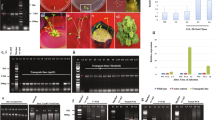Abstract
Reduction of shoot growth, leaf epinasty and chlorosis in young tomato plants (Lycopersicon esculentum Mill. cv. Hellfrucht/Frühstamm) treated hydroponically with 10-7 M of the herbicide quinclorac were partially compensated when the plants were simultaneously sprayed with salicyclic acid or the oxime ether derivative PACME. Since salicyclic acid and PACME are known inhibitors of ethylene biosynthesis, it is suggested that this pathway is implicated in quinclorac action. Further support for this hypothesis was obtained in experiments with transgenic tomato plants containing an antisense gene to 1-aminocyclopropane-1-carboxylic acid (ACC) synthase in ethylene biosynthesis. When quinclorac was applied via the root antisense plants showed reduced phenotypical alterations compared to those of wild-type plants.
Access this article
We’re sorry, something doesn't seem to be working properly.
Please try refreshing the page. If that doesn't work, please contact support so we can address the problem.
Similar content being viewed by others
References
Abeles FB, Morgan PW and Saltveit ME (1992) In: Abeles FB, Morgan PW and Saltveit ME (eds) Ethylene in Plant Biology. San Diego: Academic Press
Grossmann K and Kwiatkowski J (1993) Selective induction of ethylene and cyanide biosynthesis appears to be involved in the selectivity of the herbicide quinclorac between rice and barnyardgrass. J Plant Physiol 142: 457–466
Grossmann K, Sauerbrey E, Fritsch HJ, Schmidt O, Rademacher W, Schulz G, Sauter H and Jung J (1991) Inhibition of ethylene production in sunflower cell suspensions by a novel oxime ether derivative. J Plant Growth Regul 10: 163–166
Leslie CA and Romani RJ (1988) Inhibition of ethylene biosynthesis by salicylic acid. Plant Physiol 88: 833–837
Linsmaier EM and Skoog F (1964) Organic growth factor requirements of tobacco tissue cultures. Physiol Plant 18: 100–127
Oeller PW, Min-Wong L, Taylor LP, Pike DA and Theologis A (1991) Reversible inhibition of tomato fruit senescence by antisense RNA. Science 254: 437–439
Siefert F, Langebartels C, Boller T and Grossmann K (1994) Are ethylene and 1-aminocyclopropane-1-carboxylic acid involved in the induction of chitinase and β-1,3-glucanase activity in sunflower cell suspension cultures? Planta 192: 431–440
Theologis A (1992) One rotten apple spoils the whole bushel: the role of ethylene in fruit ripening. Cell 70: 181–184
Tittle FL, Goudey JS and Spencer MS (1990) Effect of 2,4-dichlorophenoxyacetic acid on endogenous cyanide, β-cyanoalanine synthase activity, and ethylene evolution in seedlings of soybean and barley. Plant Physiol 94: 1143–1148
Wuerzer B and Berghaus B (1985) Substituted quinolinecarboxylic acids-new elements in herbicide systems. Proc 10th Asian-Pac Weed Sci Soc Conf, pp 177–184
Yang SF, Yip WK, Satho S, Miyazaki JH, Jiao X, Liu Y and Su LY (1988) Metabolic aspects of ethylene biosynthesis. In: Pharis RP and Rood SB (eds) Plant Growth Substances 1988, pp 291–299. Berlin: Springer-Verlag
Yip WK, Moore T and Yang SF (1992) Differential accumulation of transcripts for four tomato 1-aminocyclopropane-1-carboxylate synthase homologs under various conditions. Proc Natl Acad Sci USA 89: 2475–2479
Author information
Authors and Affiliations
Rights and permissions
About this article
Cite this article
Grossmann, K., Schmülling, T. The effects of the herbicide quinclorac on shoot growth in tomato is alleviated by inhibitors of ethylene biosynthesis and by the presence of an antisense construct to the 1-aminocyclopropane-1-carboxylic acid (ACC) synthase gene in transgenic plants. Plant Growth Regul 16, 183–188 (1995). https://doi.org/10.1007/BF00029539
Received:
Accepted:
Issue Date:
DOI: https://doi.org/10.1007/BF00029539




